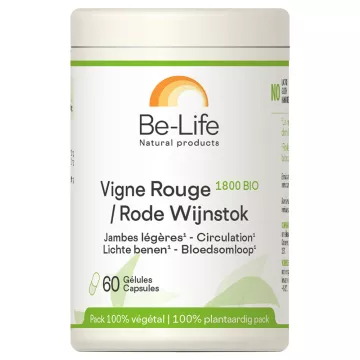When legs start to drag at the end of the day, red vine can really make a difference. On Soin-et-Nature, we have selected formulas based on this plant renowned for its benefits on blood circulation. Whether it's to relieve heavy legs, improve venous comfort or simply feel lighter on a daily basis, red vine is a precious ally, particularly in cases of mild venous insufficiency.
More details
In Greek medicine, the leaves and tendrils were recommended for topical application against headaches, while the fruit juice was used to treat diarrhea and liver disorders. The leaves are reputed to be astringent, and in the 19th century were recommended for chronic diarrhea, dysentery and hemorrhage, hence the use of leaf powder for uterine and nasal bleeding. In folk medicine, the sap is reputed to be an oral diuretic, and is useful against scabs and ophthalmia. The ashes of the vine shoots are also reputed to be diuretic. Mature leaves and tendrils are tonic, diuretic and veinotonic.
Leclerc (20th century) recommends them for puberty circulatory disorders, rosacea and varicose veins, but preference is given to red leaves, rich in tannins. Today, in Europe, the leaf is popularly renowned for its natural astringent and homeostatic properties, and its use in the treatment of diarrhea, bleeding, hemorrhoids, varicose veins and circulatory disorders of venous origin.
The red vine(Vitis vinifera L.), a member of the Vitaceae family, is a climbing plant widely cultivated throughout the world, mainly for its fruit, grapes, and for wine production. Well-known for its importance in the wine industry, it also stands out for its medicinal properties, particularly appreciated in phytotherapy.
Red vine leaves concentrate bioactive compounds such as flavonoids and anthocyanins, which have antioxidant, anti-inflammatory and venotonic properties. These compounds play a key role in the treatment of venous circulation disorders, notablychronic venous insufficiency, characterized by poor blood circulation in the legs.
Native to the temperate regions of the Old World, red vines once ranged from southeastern Europe to central Asia. Today, it is grown on every continent except Antarctica. This climbing plant, which can grow up to six meters long thanks to its tendrils, has deep roots that can penetrate up to 15 meters into the ground.
Red vine is used in phytotherapy in a variety of forms, adapted to different therapeutic needs. These include herbal teas, solid preparations for oral use (capsules, tablets, powders) and creams for cutaneous application. The recommended dose for adults is between 360 and 720 mg of dry extract per day by mouth, with a recommended treatment duration of 12 weeks. First effects can be seen after around 4 weeks.
For these conditions, herbal tea and dry extract are also effective, with a shorter treatment period, generallyone week.
Contraindications:
Possible side effects:
Interactions and precautions for use:
Topical use:
Leaf :
Fruit: grapes (stalk, skins, seeds and pulp)
The leaf, available in pharmacies and over-the-counter, has a Community monograph from the EMA and a control monograph in the French Pharmacopoeia. It is listed as a medicinal plant in the French Pharmacopoeia and is authorized as an ingredient in dietary supplements in France.
Soin-et-Nature offers a complete range of food supplements dedicated to circulatory health, designed to meet the various needs related to blood circulation. Here are the main categories available:
These dietary supplements for circulation, available on Soin-et-Nature, enable you to take care of your circulatory system and regain comfort and lightness on a daily basis.